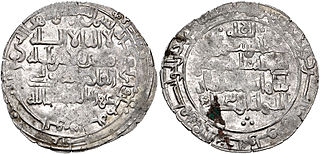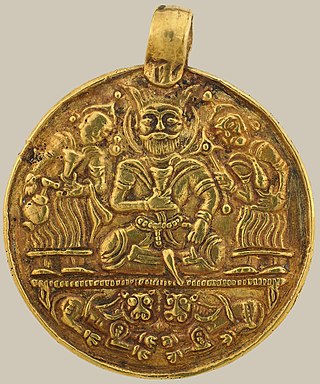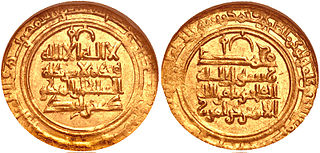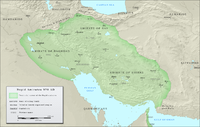
The Buyid dynasty or Buyid Empire was a Zaydi and later Twelver Shi'a dynasty of Daylamite origin. Founded by Imad al-Dawla, they mainly ruled over central and southern Iran and Iraq from 934 to 1062. Coupled with the rise of other Iranian dynasties in the region, the approximate century of Buyid rule represents the period in Iranian history sometimes called the Iranian Intermezzo.

Abū Ja'far Abdallah ibn Aḥmad al-Qādir, better known by his regnal name al-Qā'im bi-amri 'llāh or simply as al-Qā'im; 8 November 1001 – 3 April 1075), was the Abbasid caliph in Baghdad from 1031 to 1075. He was the son of the previous caliph, al-Qadir. Al-Qa'im's reign coincided with the end of the Buyid dynasty's dominance of the caliphate and the rise of the Seljuk dynasty.

Abu Nasr Khusrau Firuz, better known by his laqab of Al-Malik al-Rahim was the last Buyid amir of Iraq. He was the son of Abu Kalijar.
Abu Tahir Firuz Khusrau, better known by his laqab of Jalal al-Dawla, was the Buyid amir of Iraq (1027–1044). He was the son of Baha' al-Dawla.

Abu Shuja, better known by his laqab of Sultan al-Dawla, was the Buyid amir of Fars (1012–1024) and Iraq (1012–1021). He was the son of Baha' al-Dawla.

Abu Nasr Firuz Kharshadh, better known by his laqab of Baha al-Dawla was the Buyid amir of Iraq (988–1012), along with Fars and Kerman (998–1012). His early reign was dominated by struggles with his rival relatives over control of the western Persian provinces, but by 998 he managed to establish his supremacy over the Buyid confederation. His reign nevertheless saw the increasing encroachment of neighbouring powers on Buyid territory, and marks the beginning of the decline of the Buyids' power. He was the third son of 'Adud al-Dawla.

Abu Kalijar Marzuban, also known as Samsam al-Dawla was the Buyid amir of Iraq (983–987), as well as Fars and Kerman. He was the second son of 'Adud al-Dawla. The Abbasids recognized his succession and conferred upon him the title Samsam al-Dawla. He lacked the qualities of his father 'Adud al-Dawla and failed to have a grip upon his state affairs. His rule was marked by revolts and civil wars.
Abu'l-Fawaris, better known by his regnal name Qawam al-Dawla, was the Buyid ruler of Kerman (1012–1028). He was the son of Baha' al-Dawla.
Abu'l-Hasan Ali ibn al-Hasan, better known by his laqab of Fakhr al-Dawla was the Buyid amir of Jibal, Hamadan (984–997) and Gurgan and Tabaristan (984–997). He was the second son of Rukn al-Dawla.

Abu Talib Rustam, commonly known by his laqab of Majd al-Dawla, was the last amir (ruler) of the Buyid amirate of Ray from 997 to 1029. He was the eldest son of Fakhr al-Dawla. A weak ruler, he was a figurehead most of his reign, whilst his mother Sayyida Shirin was the real ruler of the kingdom.

The Kakuyids were a Shia Muslim dynasty of Daylamite origin that held power in western Persia, Jibal and Kurdistan. They later became atabegs (governors) of Yazd, Isfahan and Abarkuh from c. 1051 to 1141. They were related to the Buyids.

Fannā (Panāh) Khusraw, better known by his laqab of ʿAḍud al-Dawla was an emir of the Buyid dynasty, ruling from 949 to 983, and at his height of power ruling an empire stretching from Makran to Yemen and the shores of the Mediterranean Sea. He is widely regarded as the greatest monarch of the dynasty, and by the end of his reign he was the most powerful ruler in the Middle East.
Abu Mansur Fulad Sutun was the last Buyid amir of Fars, ruling more or less continuously from 1048 until his death. He was the son of Abu Kalijar.

Masʽud I of Ghazni, known as Amīr-i Shahīd, was sultan of the Ghaznavid Empire from 1030 to 1040. He rose to power by seizing the Ghaznavid throne from his younger twin Mohammad, who had been nominated as the heir upon the death of their father Mahmud of Ghazni. His twin was shortly blinded and imprisoned. However, when much of Masʽud's western domains had been wrested from his control, his troops rebelled against him and reinstated Mohammad to the throne.

Muhammad ibn Rustam Dushmanziyar, also known by his laqab of Ala al-Dawla Muhammad, was a Daylamite military commander who founded in 1008 the short-lived but important independent Kakuyid dynasty in Jibal. He is also known as Pusar-i Kaku, Ibn Kakuyeh, Ibn Kakuya, and Ibn Kaku, which means maternal uncle in the Deylami language, and is related to the Persian word "kaka". Muhammad died in September 1041 after having carved out a powerful kingdom which included western Persia and Jibal. However, these gains were quickly lost under his successors.

Abu Mansur Faramurz, mostly known as Faramurz, was the Kakuyid Emir of Isfahan. He was the eldest son of Muhammad ibn Rustam Dushmanziyar. In 1051, He was defeated by Tughril, sultan of the Seljuk Empire, and became his vassal. Faramurz later died after 1063, probably in the 1070s.
Abu Mansur Khusrau Firuz, better known by his laqab of Al-Malik al-Aziz, was a Buyid prince who served as the governor of Wasit. He was the son of Jalal al-Dawla.
Bahram ibn Mafinna, also known as al-'Adil was an Iranian statesman who served as the vizier of the Buyid ruler Abu Kalijar from 1025/6 to 1041/2.
Abu Tahir Muhammad ibn Muhammad ibn Baqiyya, also known as Nasir-al-Dawla, Naseh, best known as Ibn Baqiyya, was a statesman of the Buyid dynasty, who served as the vizier of Izz al-Dawla from 973 to 977.
Qirwash ibn al-Muqallad, also known by the honorific Muʿtamid al-Dawla, was the third Uqaylid emir of Mosul, and ruler of other towns in Iraq, from 1001 to 1050. An ambitious ruler, like the other petty rulers of the region he was engaged in a constant struggle of shifting alliances and enmities to keep and extend his domains. This involved his nominal overlords the Buyid emirs of Baghdad, other Bedouin tribes, local warlords and administrators, and even members of his own tribe and family who begrudged his position. In 1010, Qirwash even briefly defected from the Abbasid allegiance and recognized the Fatimid Caliphate in Cairo instead. He was eventually defeated, imprisoned and deposed by his brother, Baraka, and died on 27 October 1052.













